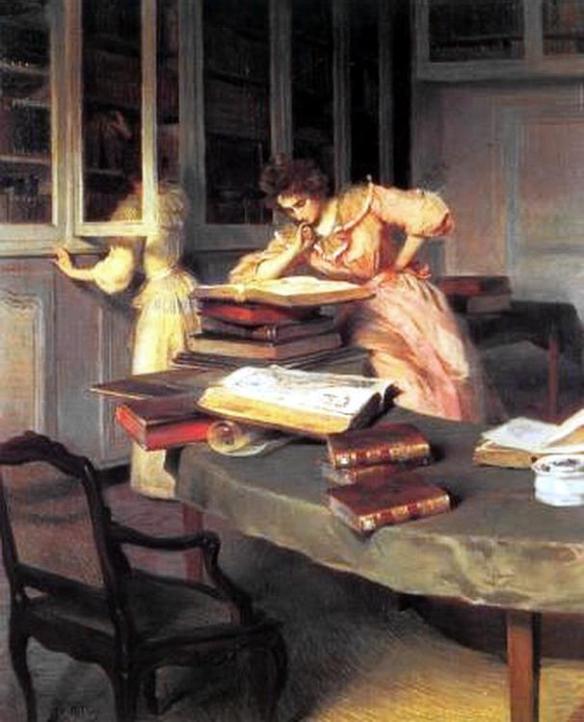I’m walking distractedly in the maze of corridors and drawn-out bookshelves. I stop a moment gazing at a small 15th century white parchment volume. I have to find a subject for my next article and I have no idea what I’m going to write about. I’m starting to become very frustrated with this lack of inspiration. Come on Charlotte, you are surrounded by tens of thousands of books and manuscripts and you are not even able to get an idea. Terribly demoralizing. And you, with your leather bind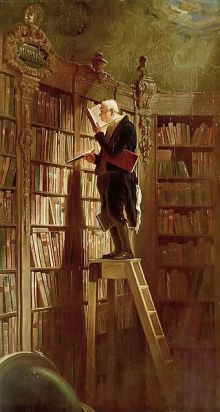 ing, stop staring at me with your shelves neighbors. I’m not able to read ancient Greek or whatever silly language you are probably written in; so leave me in peace. Discouraged by my literary meandering, that is until my eyes catch a poster in a wall. A very ordinary one, not even a good quality one, probably just hanged here to brighten up the place. I often pass it, I often look at it, but today I won’t overlook it, you bookworm!
ing, stop staring at me with your shelves neighbors. I’m not able to read ancient Greek or whatever silly language you are probably written in; so leave me in peace. Discouraged by my literary meandering, that is until my eyes catch a poster in a wall. A very ordinary one, not even a good quality one, probably just hanged here to brighten up the place. I often pass it, I often look at it, but today I won’t overlook it, you bookworm!
Bookworm is indeed the title of a painting, the one in the poster, by the German Carl Spitzweg (1808-1885), depicting a bibliophile in his library. It is interesting to analyse the imagery of what an English speaker would call a bookworm. In German, the name of the painting is Bücherwurm. Metaphorically, the book-lover is also embodying by this lovely invertebrate that would gnaw a book with pleasure. In Swedish, the term used is bokmal. This time, the book addict is compared with this incredibly attractive insect: the moth. The ones who greedily eat your clothes and food. As for the French native, the book-lover is nothing less than un rat de bibliothèque. Another kind of lovable, noisome parasite. The poor poet and his books, another painting by Carl Spitzweg:
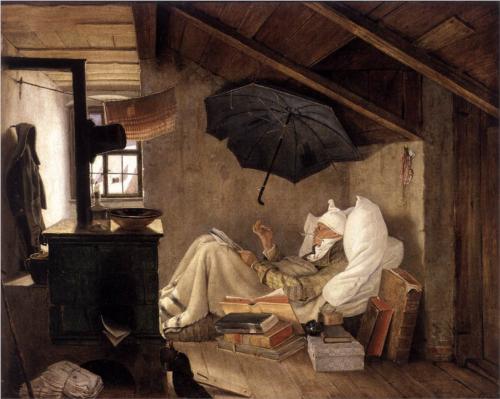 Alleluia! I get it! I won’t offend the reader by writing an article about a plain poster. But what about saying some more words about bibliophilism? “Read in order to live” once wrote Gustave Flaubert to his correspondent Mlle de Chantepie.
Alleluia! I get it! I won’t offend the reader by writing an article about a plain poster. But what about saying some more words about bibliophilism? “Read in order to live” once wrote Gustave Flaubert to his correspondent Mlle de Chantepie.
After investigation, here I am again in front of a white parchment book. This one was printed in 1498 in Lyon. It is a Latin version of the Narrenschiff, in English, Ship of Fools, a satire written by the humanist and German theologian Sebastian Brant (1457-1521), first published in 1494. It was a real best seller published many times during its author’s lifetime and translated very quickly into Latin and French and then into English. Wonderful! Now I have in my hands another edition in Latin, also from 1498 but printed in Basel. The Cultural Heritage Group sheltered four books of this masterpiece published in the 16th century and several others from later centuries. Our two editions from 1498:
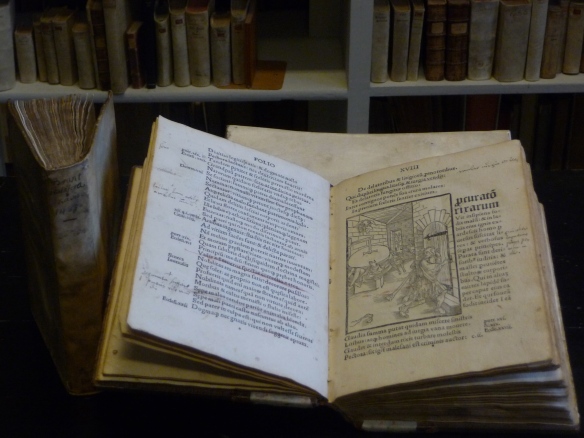 In this tale, Brant produces a portrait of 112 fools: from the clerk to the wise man passing by the traveler or the bad parents. No one is spared under his sarcastic pen. Whether discussing complacency, adultery, usury or many others sins, foibles and faults, his biting descriptions are full of humor. And you don’t even need to read the book from the beginning to the end (I mean no one will judge you…will we?) You can just quite simply open it and choose what type of fool you want to read about. And for those lazy readers, good news for you: this is a picture book so you can even just enjoy the splendid woodcuts that depict each fool. Whatever it is, you will, for sure, be delighted and amused by Brant’s analysis and allegorical idea of gathering all his characters in a ship for a journey to the land of Narragonia, a fictitious country.
In this tale, Brant produces a portrait of 112 fools: from the clerk to the wise man passing by the traveler or the bad parents. No one is spared under his sarcastic pen. Whether discussing complacency, adultery, usury or many others sins, foibles and faults, his biting descriptions are full of humor. And you don’t even need to read the book from the beginning to the end (I mean no one will judge you…will we?) You can just quite simply open it and choose what type of fool you want to read about. And for those lazy readers, good news for you: this is a picture book so you can even just enjoy the splendid woodcuts that depict each fool. Whatever it is, you will, for sure, be delighted and amused by Brant’s analysis and allegorical idea of gathering all his characters in a ship for a journey to the land of Narragonia, a fictitious country.
 And do you know who the first to join the ship is? The bookish fool, of course!
And do you know who the first to join the ship is? The bookish fool, of course!
If on this ship I’m number one
For special reasons that was done,
Yes, I’m the first one here you see
Because I like my library.
Of splendid books I own no end,
But few that I can comprehend;
cherish books of various ages
And keep the flies from off the pages.
Where art and science be professed
I say: At home I’m happiest,
I’m never better satisfied
Than when my books are by my side. (…)
 The illustrations are actually as exquisite as the text, which is not really surprising when you know that it was realized by the great Albrecht Dürer (1471-1428) among others.
The illustrations are actually as exquisite as the text, which is not really surprising when you know that it was realized by the great Albrecht Dürer (1471-1428) among others.
The bookish fool is sitting at his reading desk, wearing a nightcap and a fool´s hood with bells, studying one of his innumerable books. On his nose sits a pair of glasses, a classical attribute of the book reader, symbolizing the prestige of reading but also its excesses. This scholar is not seeing the world with his own eyes but by peering at printed words.
If the woodcuts of this book are truly admirable, I also was pleasantly surprised to discover some annotations made in olden times on our Lyon´s edition. Well, it is very common to find marginal notes but here it is actually mainly drawings. Winsome pictures that seem to have been made by a young boy or at least in a very childish fashion. Not to say that I would do any better, in fact, because my drawing skills leave something to be desired. Besides, I wouldn´t draw on my books anyway.
One might reasonably assume that a place such Carolina Rediviva, full of librarians, is also a lair for bibliophiles. Indeed, there is always this tricky moment where you have to reveal your real identity to your colleagues: “you know I’m not a librarian but an historian…” Puzzled faces. “But I do love books, I really do!” Reassured faces.
Book-lovers cannot help but read, passionately, intensely. The Englishman Richard de Bury (1287-1345) was one of them. He wrote, in Latin, The Philobiblon, a collection of essays concerning the acquisition, preservation, and organization of books:
“Books delight us (…). How highly must we estimate the wondrous power of books, since through them we survey the utmost bounds of the world and time, and contemplate the things that are as well as those that are not, as it were in the mirror of eternity. In books we climb mountains and scan the deepest gulfs of the abyss; in books we behold the finny tribes that may not exist outside their native waters, distinguish the properties of streams and springs and of various lands; from books we dig out gems and metals and the materials of every kind of mineral, and learn the virtues of herbs and trees and plants, and survey at will the whole progeny of Neptune, Ceres, and Pluto”.
The bookworm, and it is an important fact, is not to be confused with someone who cannot help but buy books. Although the book-lover might also be a collector, he first and foremost likes to read books, which is not necessary the case with bibliomaniacs.
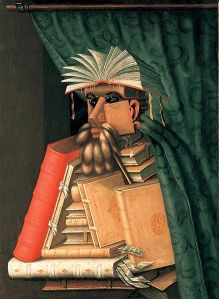 Regardless, I highly recommend that you take a trip to Skokloster Castle, only 50 kms from Uppsala. This baroque masterwork keeps in his stately walls a painting by the famous Giuseppe Archimboldo (1527-1593) called the Book man or The Librarian. We recognize in it the whole art of the Italian painter. It is a still-life painting and, in apparent self-contradiction, a portrait. A lover of books made up of books: his glasses are book cabinet keys while the duster in animal tails has been transformed into a beard. But behind this work, one might discern a possible critique of collectors that only wish to own books instead of reading them.
Regardless, I highly recommend that you take a trip to Skokloster Castle, only 50 kms from Uppsala. This baroque masterwork keeps in his stately walls a painting by the famous Giuseppe Archimboldo (1527-1593) called the Book man or The Librarian. We recognize in it the whole art of the Italian painter. It is a still-life painting and, in apparent self-contradiction, a portrait. A lover of books made up of books: his glasses are book cabinet keys while the duster in animal tails has been transformed into a beard. But behind this work, one might discern a possible critique of collectors that only wish to own books instead of reading them.
As for the bibliophile, he can quite naturally read anywhere but the book must fit the situation. There is the book you read in your armchair, the one you devour in your bed. Another one is tailor-made for kitchen reading or train getaways. But the latter cannot be the one you will enjoy in the gloomy attic or the blossoming garden. As far as Marcel Proust is concerned, it is the toilets which appear to be a perfect reading location and much more than just a place for vile bodily usage: “for all my occupations which required an inviolable solitude: reading, reverie, tears and sensual pleasure”. This statement is quite obviously shared by Henry Miller: “All my good reading was done in the toilet. (…). There are passages of Ulysses which can be read only in the toilet if one wants to extract the full flavor of their content”.
Each and every person has his or her own favourite reading spot but the most important thing is to read, wherever it is and whatever it is because, as Voltaire brilliantly wrote it in his satirical pamphlet Concerning the Horrible Danger of Reading, books, “dissipate ignorance, the custodian and safeguard of well-policed states”. Elegant women in a library by Edouard Gelhay (1856-1939):
The book-lovers should watch the movie 84, Charing Cross Road starring Anne Bancroft and Anthony Hopkins: http://www.youtube.com/watch?v=4WxA856czQY
L’amour des livres written by Jules Janin: http://www.bmlisieux.com/curiosa/janin05.htm






